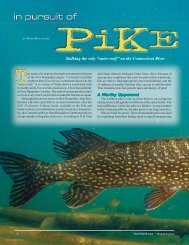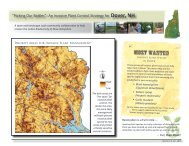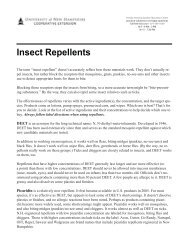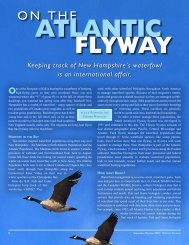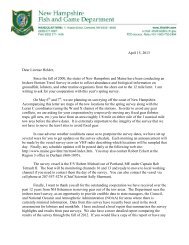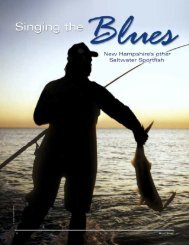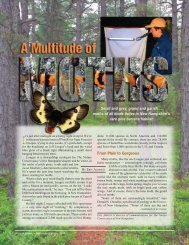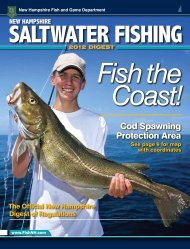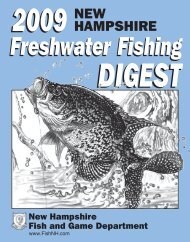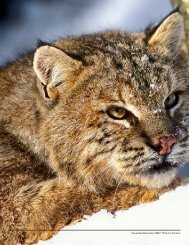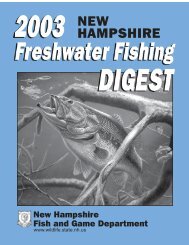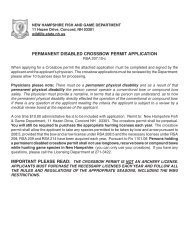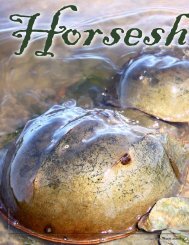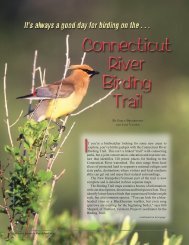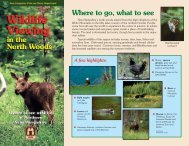Endangered Animals Cirriculum For PDF - New Hampshire Fish and ...
Endangered Animals Cirriculum For PDF - New Hampshire Fish and ...
Endangered Animals Cirriculum For PDF - New Hampshire Fish and ...
Create successful ePaper yourself
Turn your PDF publications into a flip-book with our unique Google optimized e-Paper software.
An Interdisciplinary Unit On<br />
ENDANGERED<br />
ANIMALS<br />
Ariane Allen Shuffleton, M. Ed. ©2002
TABLE OF CONTENTS<br />
Introduction <strong>and</strong> Background Information 4<br />
Unit Goals <strong>and</strong> Lesson Plans 5<br />
Spelling Words <strong>and</strong> Dictation Sentences 19<br />
Writing Topics 19<br />
Graphs 20<br />
Helpful Organizations 20<br />
Literature List 21<br />
List of <strong>Endangered</strong> <strong>and</strong> Threatened Species in N.H. 25<br />
Lesson Credits 26<br />
This booklet is printed through funds made available from the <strong>New</strong> <strong>Hampshire</strong><br />
<strong>Fish</strong> <strong>and</strong> Game Department Nongame <strong>and</strong> <strong>Endangered</strong> Wildlife Program<br />
Copies are available from:<br />
<strong>New</strong> <strong>Hampshire</strong> <strong>Fish</strong> <strong>and</strong> Game Department<br />
Wildlife Education Unit<br />
2 Hazen Drive<br />
Concord, NH 03301
INTRODUCTION AND BACKGROUND INFORMATION<br />
Americans list the environment as one of our prime concerns. The problems<br />
our generation faces are becoming more alarming every day. Although<br />
“endangered animals” is only one topic related to the environment, wildlife is<br />
considered by some an “environmental barometer”. (“Wildlife, The Environmental<br />
Barometer” – brochure, Wildlife Management Institute, Washington, D.C.)<br />
Wildlife exists where nature is balanced. Some scientists estimate the current<br />
extinction rate is more than 1,000 times the natural rate of extinction. (“Windows<br />
on the Wild” – World Wildlife Fund 1999)<br />
Although extinction itself is a natural phenomenon, it is today’s accelerated<br />
rate which is not natural. Humans are altering the environment to such a degree<br />
that many animals cannot adapt – therefore they die. Other species are being<br />
illegally hunted or trapped at a rate that is also causing extinction. Oil spills,<br />
pesticides, acid rain, <strong>and</strong> solid wastes are finding their way into animals’ digestive<br />
tracts <strong>and</strong> skin, which is still another reason animals are disappearing from<br />
our earth. If, in fact, wildlife is an “environmental barometer”, the human<br />
species is also in trouble.<br />
When a species is extinct, that means it no longer exists anywhere on the<br />
earth; it is gone forever. <strong>Endangered</strong> animals are in danger of becoming extinct.<br />
Threatened animals are animals that will probably become endangered unless<br />
something is done to help them.<br />
The federal government passed the <strong>Endangered</strong> Species Act in 1973. This<br />
law protects listed endangered <strong>and</strong> threatened species from being hunted,<br />
collected, sold, or used in any way without a permit. States set l<strong>and</strong> aside solely<br />
for wildlife. Zoos study endangered animals <strong>and</strong> attempt to breed them in<br />
captivity. “Foster parenting” is another method used with some species to<br />
increase their numbers (for example, the whooping crane).<br />
You don’t have to be a scientist or a governor to help in the fight against<br />
extinction. You can help to enforce wildlife laws. You can avoid buying products<br />
that are made from endangered animals (it’s illegal in this country). You can write<br />
letters to your congressmen. You can support wildlife organizations. Most of all,<br />
you can learn about endangered animals <strong>and</strong> teach others.<br />
Educators can adapt the lessons <strong>and</strong> ideas to meet their own class needs, as<br />
I did for our second grade. Enjoy!<br />
Ariane Allen Shuffleton<br />
4
UNIT GOALS<br />
The goals of this unit are as follows:<br />
1. Students will develop empathy, concern, <strong>and</strong> awareness of <strong>and</strong> about<br />
endangered animals.<br />
2. Students will underst<strong>and</strong> the major factors that cause animals to<br />
become rare, threatened, endangered, <strong>and</strong> extinct (habitat destruction,<br />
over specialization, pollution, <strong>and</strong> poaching).<br />
3. Students will gain an underst<strong>and</strong>ing of what is presently being done to<br />
save endangered animals.<br />
4. Students will explore their own ideas of what needs to be done, as well<br />
as what individuals <strong>and</strong> groups can do, to help save endangered<br />
animals.<br />
5. In pairs, students will research an animal in order to gain an in-depth<br />
underst<strong>and</strong>ing of the problems <strong>and</strong> possible solutions for a particular<br />
endangered animal.<br />
5
UNIT OUTLINE<br />
Lesson 1<br />
Lesson 2<br />
Lesson 3<br />
Lesson 4<br />
Lesson 5<br />
Lesson 6<br />
Lesson 7<br />
Lesson 8<br />
Lesson 9<br />
Lesson 10<br />
Lesson 11<br />
Lesson 12<br />
Lesson 13<br />
Lesson 14<br />
Lesson 15<br />
Brainstorming Prior Knowledge<br />
Apple Demonstration<br />
Animal Interviews<br />
Habitat <strong>and</strong> Its Components<br />
From the Wild to Captivity<br />
Human Alterations in the Environment<br />
Acid Rain: An Experiment<br />
Carrying Capacity <strong>and</strong> Crowding<br />
Plastic Food<br />
Chopping Down the <strong>For</strong>est<br />
Oil Pollution: An Experiment<br />
More Than One Reason<br />
Susceptibility to Extinction<br />
Bumper Stickers <strong>and</strong> Pins: Make a Statement<br />
Harmful Activities <strong>and</strong> Alternatives<br />
6
Lesson 1 – Brainstorming Prior Knowledge<br />
Objective: Find out what students know about endangered animals.<br />
Method: Brainstorm prior knowledge<br />
Material: Chalkboard or large piece of paper to record what students say.<br />
Procedure: Write “<strong>Endangered</strong> <strong>Animals</strong>” on the top of the paper or on the chalkboard.<br />
Ask students what they know about endangered animals. Record all responses, correct<br />
<strong>and</strong> incorrect.<br />
Note: Save this for the end of the unit; cross out incorrect responses at this time, <strong>and</strong><br />
add other facts that were learned during the unit.<br />
Lesson 2 – Apple Demonstration<br />
Objective: At the end of this lesson, students will have a better underst<strong>and</strong>ing of how<br />
small an area of the earth humans <strong>and</strong> all other l<strong>and</strong> dwelling animals live.<br />
Method: Demonstration<br />
Materials: A whole apple, a knife, <strong>and</strong> a cutting board, globe for comparison<br />
Procedure: Have the students sit so they can see the demonstration. Create a “serious”<br />
atmosphere. Tell them that we are going to pretend that this apple is the earth. Discuss how<br />
the apple is similar to the earth. Ask the students to guess how much of the earth (apple)<br />
they think people <strong>and</strong> animals that live on the l<strong>and</strong> occupy.<br />
• 70-75% of earth is covered with oceans; cut the apple in fourths <strong>and</strong> push<br />
3 quarters to the side.<br />
• 30% of what remains is too dry for life to exist; cut 1/3 away <strong>and</strong> push<br />
to the side.<br />
• 30% of what remains is too mountainous for life to exist; cut another 1/3<br />
away <strong>and</strong> push to the side.<br />
• Of the remaining portion, only the surface (skin) is used for living space;<br />
trim off the skin.<br />
• Ask the students “How long until we use it up?” Don’t wait for a response;<br />
eat skin.<br />
Have students write for five minutes to express their feelings, thoughts, <strong>and</strong> ideas to<br />
“save the earth”. Students who wish can then share their responses.<br />
7
Lesson 3 – Animal Interviews<br />
Objective: Students will become aware of reasons why some animals are endangered.<br />
Each student will examine an endangered animal by researching, writing, <strong>and</strong><br />
verbally describing the problems of a particular animal. Students will design their<br />
own costumes <strong>and</strong> props for interviews.<br />
Method: Research, write reports, interviews with classmates<br />
Materials: Resource folders containing information about an animal, its habitat, its status<br />
(endangered, threatened, rare), its problems/reasons for being endangered, etc. (one folder<br />
per two children). Teacher makes these in advance. Materials for props <strong>and</strong> costumes.<br />
Procedure: Teacher models an interview (s/he dresses up or makes a puppet);<br />
introduce yourself <strong>and</strong> ask students to write down a question to ask this animal.<br />
Tell the students some facts about yourself (the animal): where you live, what you<br />
eat, your life cycle, etc. then allow the students to interview you. Students research<br />
animals in pairs; when a pair is ready, let their classmates interview them. A “data<br />
sheet” listing the type of information they are expected to know might be helpful.<br />
Note: Model an interview at the beginning of the unit. Allow the students ample time<br />
to research their animal, <strong>and</strong> then make the interviews the culminating project for the<br />
unit. In the following lessons, when I refer to “an animal”, students can work with their<br />
partners, <strong>and</strong> use “their animals” as the focus of the lessons.<br />
Lesson 4 – Habitat <strong>and</strong> Its Components<br />
Objective: Students will be able to define “habitat” <strong>and</strong> identify its components.<br />
Students will brainstorm, then organize <strong>and</strong> synthesize the information.<br />
Method: Brainstorm. Draw <strong>and</strong> label parts of own habitat, then of an animal’s habitat<br />
Materials: Chalkboard, drawing paper, crayons.<br />
Procedure: On the board make two columns with headings “people” <strong>and</strong> “wildlife”.<br />
Ask the students what people need in order to survive; write down all responses. Do<br />
the same for wildlife heading. Go back over the lists to try to narrow each one of them<br />
down to water, food, shelter, space, arrangement, sunlight, air, <strong>and</strong> soil.<br />
• Define habitat: home for animals, what they need in order to survive.<br />
• Add “pets” <strong>and</strong> “plants”. Do these have the same components?<br />
• Have students draw pictures of their own habitats (homes) <strong>and</strong> label water,<br />
food, shelter, space, <strong>and</strong> arrangement. Share the pictures, then have<br />
students draw pictures of an animal’s habitat <strong>and</strong> label the parts.<br />
Note: If students have a hard time with arrangement, ask them how convenient it<br />
would be if their bathroom were two miles from their house!<br />
8
Lesson 5 – From the Wild to Captivity<br />
Objective: Students will be able to identify <strong>and</strong> analyze problems that occur when<br />
animals are moved from the wild to captivity. Students design zoo environments for<br />
endangered animals that satisfy all the needs for that particular animal.<br />
Method: Discussion, drawings<br />
Materials: Drawing paper, crayons<br />
Procedure: Review the definition of “habitat”. List components on board (water, food,<br />
space, protection, arrangement).<br />
• Discuss different types of habitat in relation to different animals.<br />
• Choose one type of animal, <strong>and</strong> list habitat requirements for that animal.<br />
• Draw a picture of that animal in a zoo with all its needs satisfied. Label<br />
the needs of the animal. Is it possible? Discuss pictures. Discuss the<br />
problems scientists <strong>and</strong> zookeepers have when they want to keep a wild<br />
animal in an enclosed area.<br />
Read: Close to the Wild by Thomas Cajacob <strong>and</strong> Theresa Burton (See “Children’s<br />
Literature” list for details)<br />
Lesson 6 – Human Alterations in the Environment<br />
Objective: Students will be able to describe some ways that humans are altering<br />
habitats, which causes some animals to become endangered.<br />
Method: Worksheet; discussion<br />
Materials: Worksheet (NatureScope “<strong>Endangered</strong> Species: Wild & Rare”), Crayons<br />
Procedure: Elicit definitions for endangered <strong>and</strong> extinct.<br />
• Show pictures of endangered animals.<br />
• Explain that the main reason species are disappearing is because humans<br />
are changing their habitats. Ask the students why people would want to change<br />
habitats.<br />
• Do worksheet together with discussion. The large pictures in the middle<br />
represent the way people are changing habitats. The smaller pictures on the top<br />
<strong>and</strong> bottom show why people change habitats.<br />
• Draw lines from the big pictures to the small pictures to show the reasons<br />
why people are changing habitats.<br />
• Discuss other ways that people are changing habitats, <strong>and</strong> why. Discuss<br />
the consequences this might have for wildlife.<br />
• Let students color the page.<br />
9
Lesson 7 – Acid Rain: An Experiment<br />
Objective: Students will formulate hypotheses, perform an experiment, <strong>and</strong><br />
evaluate the results. Students will be able to draw conclusions about the way acid<br />
rain affects plant <strong>and</strong> animal life.<br />
Method: Experiment with plants <strong>and</strong> vinegar<br />
Materials: Four bean plants (plant two ahead of time), two peperomia plants, two<br />
jade plants, vinegar, water, plastic bag, paper towels, two spray bottles, ruler.<br />
Procedure: While students are out of the room, wet 4 or 5 paper towels with vinegar<br />
<strong>and</strong> place them around the room. When students enter the room <strong>and</strong> notice the smell,<br />
discuss how people get rid of smells (place smelly paper towels in a plastic bag <strong>and</strong><br />
throw away). <strong>Animals</strong> don’t have the ability to get away from some types of pollution.<br />
• Does anyone know what acid rain is? Discuss.<br />
• Draw a simple picture of smokestacks, pollution filled clouds moving<br />
away, <strong>and</strong> then falling as rain in a pond with fish, fish die or are eaten by a<br />
bird, etc.<br />
• Bring out plants <strong>and</strong> spray bottles. Explain to the students that acid<br />
rain sometimes is as acidic as vinegar. Label one bottle “acid rain”<br />
(vinegar) <strong>and</strong> the other water. Have one student spray half the plants with<br />
water, <strong>and</strong> another student spray the other plants with acid rain. Label<br />
the plants. Determine how much liquid should be sprayed on the plants<br />
(for example, ten pumps). <strong>For</strong>mulate a hypotheses about acid rain <strong>and</strong><br />
how it might affect the plants. Fill out charts. Charts should include a date,<br />
color, height, width, <strong>and</strong> comments for each plant.<br />
Optional: Start two other plants as seedlings. What effect does acid rain have<br />
on these plants? Continue this for several days (two weeks is a good<br />
length of time). Discuss how acid rain could affect animals by getting in<br />
the food chain.<br />
<strong>For</strong> background, read: “Acid rain: Effects on fish <strong>and</strong> wildlife”, US department of<br />
the Interior, <strong>Fish</strong> <strong>and</strong> Wildlife service, Leaflet 1, Washington, D.C., 1985; “The<br />
Acid Rain Story”, Friends of the Earth / EPI / OS, Washington, D.C., 1985.<br />
11
Lesson 8 – Carrying Capacity <strong>and</strong> Crowding<br />
Objective: Students will be able to define “carrying capacity”. Students will become<br />
more sympathetic toward animals whose habitat is being destroyed.<br />
Method: Students experience crowding; discussion<br />
Procedure: Ask for a student volunteer.<br />
• Approach the student, asking when the closeness feels uncomfortable.<br />
• Discuss types of physical <strong>and</strong> emotional reactions. Does one feel the same<br />
with family or close friends? <strong>Animals</strong> also feel uncomfortable when<br />
approached; discuss reasons why (fear of predation, protect young).<br />
• Discuss why are some animals more comfortable around humans than<br />
others (fly, quick, swim, size, alone or in group).<br />
• Now have students all sit very close together; how do they feel? What<br />
would happen if animals were crowded? Would they survive? What do they<br />
need to survive? What might an animal do if it were crowded? (Leave, attack,<br />
disease, die, not enough food) What kinds of human intervention could occur<br />
which would help wildlife? (Reintroduce predators, winter-feeding, plant<br />
additional vegetation, relocate animals, hunting)<br />
• Define “carrying capacity” – The number of plants <strong>and</strong> animals that an<br />
environment can support. Why is this important? What is the carrying capacity<br />
for the classroom?<br />
Lesson 9 – Plastic Food<br />
Objective: Students will be able to describe the potential harmful effects of plastic<br />
<strong>and</strong> garbage on wildlife. Students will formulate <strong>and</strong> identify possible solutions to the<br />
problems that exist with waste.<br />
Method: Student examines waste <strong>and</strong> learns about its effects on wildlife<br />
Procedure: Teacher collects garbage for a couple of days (the students could collect it).<br />
Examine each article. Discuss how it could be perceived as food. Try to identify some<br />
animals that might perceive it as food. How might these materials affect animals if<br />
ingested or otherwise be harmful?<br />
Show pictures of garbage <strong>and</strong> animal interactions. What are some possible solutions to<br />
these problems?<br />
Homework: Tell students to list 30 plastic items found in their home. The next day,<br />
share lists. Make a classroom list.<br />
<strong>For</strong> Background, read: “Oceans at Risk”, <strong>Animals</strong>, Jan/Feb 1989, p. 7-23.<br />
12
Lesson 10 – Chopping Down the <strong>For</strong>est<br />
Objective: Students will be able to describe some ways that wildlife is affected by<br />
deforestation.<br />
Method: Brainstorming; students create a “human forest”; discussion<br />
Materials: Fan; chalkboard or large piece of paper<br />
Procedure: Draw a picture of a forest on the board.<br />
• Tell the students that a road is going to be put through the middle of this<br />
forest. Erase a strip through the forest. Ask the students how this might affect<br />
the wildlife. Discuss <strong>and</strong> list all responses.<br />
• Have the students st<strong>and</strong> very close together in a big group with their<br />
arms up (human forest). Ask the child in the center to describe what he or<br />
she sees when “looking through the trees”. (How much light is on the<br />
floor? See me? See the rest of the room?)<br />
• Turn on a fan at the edge of the human forest. Can the center student feel<br />
the breeze? Hear the fan?<br />
• Begin to “chop down” the forest by removing the kids near the edge. Have<br />
the center child report any changes. Continue to chop down the forest until the<br />
center child is at the edge of the forest (you might find your “forest”<br />
moves!). Ask students what happened to the area that used to be the<br />
center of the forest (now it’s the edge). How might this affect wildlife that<br />
used to live in the center?<br />
• Discuss <strong>and</strong> add to list.<br />
Read: Read Roadside by David Bellamy. (See “Children’s Literature” list for<br />
details.)<br />
13
Lesson 11 – Oil Pollution: An Experiment<br />
Objective: Students will formulate hypotheses, perform an experiment, <strong>and</strong> evaluate<br />
the results. Students will also be able to draw conclusions about the way an oil spill<br />
can cause species to become endangered.<br />
Method: Experiment with oil <strong>and</strong> eggs<br />
Materials: Oil, water, 4 hard-boiled eggs, blue food coloring, eye dropper, 2 cup<br />
bowl, measuring cup<br />
Procedure: Ask the students if they heard about the Exxon Oil spill in Prince William<br />
sound, Alaska. Discuss it <strong>and</strong> its effects on wildlife <strong>and</strong> people. Note how far away we<br />
are from Alaska.<br />
We can have our own spill in the classroom!<br />
• Peel, <strong>and</strong> then pass between the students, a regular hard-boiled egg<br />
(control egg).<br />
• Mix ½ cup oil, 10 drops of blue food coloring, <strong>and</strong> ½ cup water in<br />
bowl. Place remaining 3 eggs in the bowl. While waiting, formulate<br />
hypotheses about what affects the oil will have on the eggs.<br />
• Remove the first egg after 5 minutes, the second egg after 15 minutes, <strong>and</strong><br />
the third egg after 30 minutes. Try to dry off the egg before peeling it.<br />
• Observe, record <strong>and</strong> discuss the results.<br />
• Discuss other effects oil spills have, such as: Harms unhatched eggs.<br />
Gets into pores of skin then into the blood stream, gets into the food chain<br />
<strong>and</strong> is digested. Gets into fur <strong>and</strong> feathers therefore they lose their ability<br />
to keep the animal warm, etc.<br />
Note: Students do this experiment in four groups of five. Each student does an<br />
observation sheet (next pages).<br />
Read: Ranger Rick, “The Big Oil Spill”, January 1990, p.32-34. The Comeback<br />
Trail, “The Deadly Effects of Crude Oil”, spring, 1989, p.1, 4 (<strong>New</strong>sletter put out<br />
by DEFENDERS OF WILDLIFE – see bibliography).<br />
14
OIL EXPERIMENT OBSERVATION SHEET<br />
Name:<br />
Before Experiment<br />
1. What do you think is going to happen to the egg that is in the mixture for<br />
a. 5 minutes<br />
b. 15 minutes<br />
c. 30 minutes<br />
During Experiment<br />
2. What does the egg look <strong>and</strong> feel like after being in the mixture for<br />
d. 5 minutes<br />
e. 15 minutes<br />
f. 30 minutes<br />
After Experiment<br />
3. What do you think would happen if we left an egg in the mixture for 24 hours<br />
(a whole day)?<br />
4. How do you think the results would change if we changed the amount of oil in<br />
the mixture?<br />
More oil<br />
Less oil<br />
5. Put a little bit of the mixture on your finger tips. Now rinse them with water.<br />
Does the mixture come off? Do your fingers still feel greasy?<br />
6. What effects do you think oil spills have on animals?<br />
7. What can people do to stop oil spills?<br />
8. What can you do?<br />
15
Lesson 12 – More Than One Reason<br />
Objective: Students will underst<strong>and</strong> that many reasons, not just one, cause animals to<br />
become extinct.<br />
Method: Students will make paper plate wheels which show the various reasons why<br />
an animal is endangered<br />
Materials: Paper plates, paper fasteners, scissors, crayons or markers.<br />
Procedure: Pass out two paper plates to each student.<br />
• Discuss reasons why animals are endangered (pollution, habitat loss,<br />
illegal hunting or trapping, nets, etc.).<br />
• Depending on the animal <strong>and</strong> its problems, divide one plate with a<br />
ruler, drawing lines (for example, turtles have at least four problems –<br />
pollution, caught in nets, illegally killed for products <strong>and</strong> habitat<br />
destruction – so divide the plate into fourths).<br />
• Label <strong>and</strong> draw the problems in each section.<br />
• Cut a triangle out of the other plate, the size of one of the sections DO<br />
NOT cut it all the way to the center.<br />
• Fasten the plate with the cut triangle on top of the plate with the sections.<br />
• Draw a picture of the endangered animal on the top plate; title your wheel.<br />
• Share wheels.<br />
Lesson 13 – Susceptibility to Extinction<br />
Objective: Students will be able to recognize the traits that make an animal susceptible<br />
to extinction.<br />
Method: Students evaluate traits of imaginary animals, then design their own animals<br />
Materials: Teacher-made up imaginary animals (2-4) with various traits (or see Nature<br />
Scope, <strong>Endangered</strong> species: Wild & Rare, p. 15); drawing paper <strong>and</strong> crayons.<br />
Procedure: Discuss imaginary animals that you have made up. Decide which out of<br />
these is most likely to go extinct first <strong>and</strong> why. Students now make up their own<br />
imaginary animals <strong>and</strong> list their traits. <strong>Animals</strong> should either be “endangered” or never<br />
go extinct. Share pictures <strong>and</strong> discuss traits.<br />
Note: Traits of imaginary animals should be things like: eats food that only grows<br />
on one tropical isl<strong>and</strong>, lays one egg every four years, is very slow, not afraid of<br />
anything, have very valuable feathers, etc.<br />
16
Lesson 14 – Bumper Stickers <strong>and</strong> Buttons: Make a Statement<br />
Objective: Students will identify button <strong>and</strong> bumper stickers designed to make a<br />
statement about some issues.<br />
Method: Students make bumper stickers <strong>and</strong>/or buttons<br />
Materials: Bumper stickers – white contact paper or oak tag, which can be<br />
laminated when completed, tape for the backs, markers. Buttons – button machine<br />
or 3" circles on white oak tag, markers, safety pins. Bumper stickers <strong>and</strong><br />
buttons for demonstration of examples.<br />
Procedure: Show examples to kids. Discuss various slogans <strong>and</strong> their purpose.<br />
• Brainstorm issues to use to make slogans.<br />
• Help kids design their own sticker or button.<br />
• Laminate or tape.<br />
• Use safety pins to attach buttons.<br />
• Share slogans <strong>and</strong> designs.<br />
Lesson 15 – Harmful Activities <strong>and</strong> Alternatives<br />
Objective: Students will evaluate a number of activities that are harmful to wildlife,<br />
<strong>and</strong> recommend alternatives.<br />
Method: Brainstorming <strong>and</strong> drawings used for discussion<br />
Materials: Cards which show humans in various activities, some that harm wildlife<br />
<strong>and</strong> others that help it. Chalkboard or pieces of paper, drawing paper, <strong>and</strong> crayons.<br />
Procedure: Brainstorm a list of activities they have seen or heard that are harmful.<br />
Divide the class into groups of 4 or 5. Start by demonstrating what to do with the<br />
cards with the whole class. Hold up a card, discuss what it shows <strong>and</strong> decide why it is<br />
harmful or why it is not harmful <strong>and</strong> if it is, what can be done to make the activity<br />
beneficial to wildlife. Give each group some cards which they must separate into two<br />
groups: harmful <strong>and</strong> not harmful. Students should then discuss alternative activities<br />
for the harmful pile. Bring the class back together. Have a spokesperson from each<br />
group share their results with the rest of the class. Pass out drawing paper, <strong>and</strong> have<br />
students make their own cards. On the back have them write the helpful alternative<br />
activity.<br />
18
SPELLING WORDS AND DICTATION SENTENCES<br />
Extinct Threatened <strong>Endangered</strong><br />
Some extinct animals were once endangered or threatened.<br />
Habitat Pollution Illegal<br />
Many animals are endangered because of habitat loss, pollution, <strong>and</strong> illegal hunting.<br />
Poachers<br />
Rare<br />
The name of animal he/she is studying<br />
The ______________ is rare because of poachers.<br />
Animal<br />
Food chain<br />
Interview<br />
Critical habitat<br />
WRITING TOPICS<br />
1. Response to Apple demonstration (Lesson #2)<br />
2. How would I save the…<br />
students write their own ideas of how they would save the endangered animal<br />
they are studying, or wildlife as a whole.<br />
3. Letters to the Senator…<br />
Students write letters to U.S. Senators <strong>and</strong> offer suggestions on what could be<br />
done to help protect endangered animals.<br />
4. Report on <strong>Endangered</strong> Animal…<br />
In pairs, students research <strong>and</strong> report on one endangered animal. Reports<br />
include information such as name, habitat, range, special features, why it is<br />
endangered, <strong>and</strong> what people are doing to help it.<br />
5. All I know about endangered animals…<br />
This assesses their knowledge about endangered animals.<br />
6. Possible Rewrites<br />
Shady Glade or Free Bird would be excellent books to rewrite.<br />
7. Illustrate poem by Beverly Armstrong “where the wild things shouldn’t be”<br />
Each student illustrates a page of the poem <strong>and</strong> then makes a class book.<br />
19
GRAPHS<br />
1. Why is the animal you are studying endangered? (Habitat destruction,<br />
pollution, hunting, other)<br />
2. Is the animal you are studying extinct, endangered, threatened, or rare?<br />
3. Does the endangered animal you are studying live on l<strong>and</strong>, water, or air?<br />
4. What kind of habitat does the endangered animal you are studying live in?<br />
(desert, mountains, jungle, salt water, fresh water, other)<br />
5. What continent does your animal live on? (Africa, South America, North<br />
America, Asia, Antarctica, Australia, Europe)<br />
6. Does the animal you are studying live above, below, or near the equator?<br />
7. Which endangered animal book did you like the best (list the books)<br />
8. What have you liked best about studying endangered animals? (list<br />
activities)<br />
9. What did you like best about the animal reports? (covers, maps, reports,<br />
viewing final products, other)<br />
HELPFUL ORGANIZATIONS<br />
Audubon Society of NH<br />
Wildlife Section<br />
3 Silk Farm Rd.<br />
Concord, NH 03301<br />
www.nhaudubon.org<br />
National Wildlife Federation<br />
1400 Sixteenth St., NW<br />
Washington, DC 20036<br />
www.nwf.org<br />
<strong>New</strong> <strong>Hampshire</strong> <strong>Fish</strong> <strong>and</strong> Game<br />
Department<br />
Nongame <strong>and</strong> <strong>Endangered</strong> Wildlife<br />
Program<br />
2 Hazen Drive<br />
Concord, NH 03301<br />
www.wildlife.state.nh.us<br />
Sierra Club<br />
Information Services<br />
730 Polk Street<br />
San Francisco, CA 94109<br />
US Department of Interior –<br />
<strong>Fish</strong> <strong>and</strong> Wildlife Services<br />
18 th <strong>and</strong> C Streets, NW<br />
Washington, DC 20240<br />
www.fws.gov<br />
Wildlife Education, Ltd.<br />
930 W. Washington Street<br />
San Diego, CA 92103<br />
www.natureserve.org<br />
www.enature.com<br />
20
LITERATURE LIST<br />
Books for Children:<br />
Althea. Leopards, Gorillas, Whales, <strong>and</strong> Parrot, Longman Group USA Inc., United<br />
States, 1988. Non-fiction; informative books about each animal listed in the titles; do<br />
deal directly with endangered species, although there is a note at the end of each book<br />
which describes their problems with humans; grades 1, 2.<br />
Arnold, Caroline. Saving the Peregrine Falcon, Carolrhoda Books, Inc.,<br />
Minneapolis, Minn., 1985. Non-fiction; discusses habitat, enemies, scientific<br />
research, problems, <strong>and</strong> solutions; grades 2 <strong>and</strong> up.<br />
Bonners, Susan. P<strong>and</strong>a, Delacote Press, <strong>New</strong> York, NY, 1978. Non-fiction; discusses the<br />
life cycle of the p<strong>and</strong>a; does not discuss the fact that p<strong>and</strong>as are endangered; grades 1, 2.<br />
Cajacob, Thomas <strong>and</strong> Burton, Teresa. Close to the Wild, Carolrhoda Books, Inc.,<br />
Minneapolis, MN, 1986. Non-fiction; Up to page 14, discusses Siberian tigers, their<br />
characteristics, endangered, <strong>and</strong> the role zoos play in helping them; page 14 <strong>and</strong><br />
beyond, discusses mating somewhat in detail; grades 2, 3 up to page 14, read aloud.<br />
McClung, Robert M. Thor Last of the Sperm Whales, William Morrow & Company,<br />
<strong>New</strong> York, NY, 1971. Fiction based on fact; begins with a legend about a sperm whale;<br />
follows the life cycle of a sperm whale; briefly discusses reasons why whales are<br />
endangered; grades 3, 4 or read aloud for younger children.<br />
Morris, Dean. <strong>Endangered</strong> <strong>Animals</strong>, Raintree Childrens Books, Milwaukee,<br />
Wisconsin, 1977. Non-fiction; overview of endangered species; discusses human<br />
impact (hunting, pollution, <strong>and</strong> habitat destruction), scientific studies, <strong>and</strong> the role<br />
zoos play in helping endangered species; grades 2, 3.<br />
National Geographic Society. <strong>Animals</strong> in Danger, National Geographic Society,<br />
Washington, DC, 1978. Non-fiction; discusses specific animals, their characteristics,<br />
<strong>and</strong> why they are endangered; grades 2, 3.<br />
Peet, Bill. Farewell to Shady Glade, Houghton Miffin Co., Boston, MA, 1966.<br />
Fiction; group of animals are forced from their home due to habitat destruction,<br />
<strong>and</strong> on their way to find a new home they experience city pollution; grades 1, 2.<br />
Roever, J.M. The Black-Footed Ferret, Steck-Vaughn Co., Austin, TX, 1972. Nonfiction;<br />
discusses many aspects of the black-footed ferret – habitat, diet, enemies,<br />
problems, <strong>and</strong> what people can do to protect wildlife; grades 2 <strong>and</strong> up, or read aloud.<br />
Ranger Rick. <strong>Endangered</strong> <strong>Animals</strong>, National Wildlife Federation, Washington, DC,<br />
1989. Non-fiction; discusses the problems endangered animals have through examples<br />
of specific species (Giant P<strong>and</strong>a, Whooping Crane, Humpback Whale, Blackfooted<br />
Ferret, Komodo dragon, Tiger, Small Cats, Crocodiles, Gorilla, Peregrine<br />
Falcon, Numbat, Wombat, Wallaby, Nene Goose, Lemurs, Black Rhino, Muriqui,<br />
<strong>and</strong> Green Sea Turtle); grades 3 <strong>and</strong> up or read aloud.<br />
21
Rice, Paul <strong>and</strong> Mayle, Peter. As Dead As A Dodo, David R. Godine, Publisher,<br />
Inc., Boston, MA, 1981. Non-fiction; one-page descriptions of animals that are<br />
extinct, <strong>and</strong> why; all ages, read aloud.<br />
Stone, A. Harris. The Last Free Bird, Prentice-Hall, Inc., Englewood, NJ, 1967.<br />
Fiction; story about bird witnessing habitat destruction; simple, yet good for all<br />
ages.<br />
Stone, Lynn M. <strong>Endangered</strong> <strong>Animals</strong>, Children’s Press, Chicago, IL, 1984. Nonfiction;<br />
defines “endangered” <strong>and</strong> “extinct”; discusses reasons why animals are<br />
endangered (hunting, pollution, introduced species, bought as pets, lack of space);<br />
discusses specific species; discusses how people are helping, including what young<br />
people can do; grades 2, 3.<br />
Weaver, John L. Grizzly Bears, Dodd, Mead, & Co., <strong>New</strong> York, NY, 1982. Nonfiction;<br />
discusses the life cycle, habit, <strong>and</strong> habitat of the grizzly; grades 2 <strong>and</strong> up.<br />
World Wildlife Fund. Our World in Danger, Ladybird Books, Inc., Loughborough,<br />
Leicestershire, Engl<strong>and</strong>, 1989. Non-fiction; discusses habitat destruction, pesticide<br />
use, overgrazing, pollution, <strong>and</strong> hunting, <strong>and</strong> the effect these have on wildlife;<br />
discusses what people can <strong>and</strong> are doing; grades 2-4.<br />
Articles from Ranger Rick Magazine:<br />
“Adventures of Ranger Rick”,<br />
August 1988, p. 34-38, (mountain gorillas)<br />
June 1988, p. 20-23 (loggerhead turtles)<br />
February 1987, p. 27-30 (habitat destruction, critical habitat)<br />
June 1985, p. 15-17 (poaching)<br />
February 1985. p. 28-31 (introduced species)<br />
September 1984, p. 16-19 (woodl<strong>and</strong> caribou, habitat destruction, hunting)<br />
November 1983, p. 21-24 (rainforest deforestation)<br />
September 1983, p. 16-19 (leatherback turtles, garbage)<br />
“The Big Oil Spill”, January 1990, p. 32-34 (Alaska’s Prince William Sound spill)<br />
“China’s Precious P<strong>and</strong>as”, July 1989, p. 22-30 (Giant p<strong>and</strong>as)<br />
“Danger: Don’t Pick a Wild Pet”, July 1980, p. 36-37 (wild animals as pets)<br />
“Eco Cops”, January 1989, p.26-28 (environmental conservation officers)<br />
“Elephant Trivia”, April 1989, p. 38-47 (elephants <strong>and</strong> their problems with humans)<br />
“Happy Bee”,<br />
June 1988, p. 12-13 (peregrine falcon, turtle eggs, ospreys)<br />
June 1982, p. 44-47 (gray whales)<br />
February 1981 p. 9-11 (sea otter, insecticides <strong>and</strong> birds, wolves, whooping<br />
cranes)<br />
“Take an Inside Look”, November 1989, p. 18-24 (lemurs)<br />
“Wild Wings Over the West”,<br />
January 1990, p.20-27 (birds of prey, including the endangered peregrine<br />
falcon)<br />
22
Books for Adults:<br />
Beatley, Timothy. Habitat Conservation, Planning, <strong>Endangered</strong> Species <strong>and</strong> Growth.<br />
1994.<br />
Brooks, F. Protecting <strong>Endangered</strong> Species, (Green Guide Series). 1991.<br />
Burgess, Bonnie. Fate of the Wild: The <strong>Endangered</strong> Species Act <strong>and</strong> the Future of<br />
Biodiversity. 2001<br />
Cadieux, Charles. These Are the <strong>Endangered</strong>, The Stone Wall Press, Inc., Washington,<br />
DC, 1981. Discusses many endangered species (approximately 30), discusses<br />
national <strong>and</strong> international laws, describes the roles of zoos, refuges, <strong>and</strong> parks,<br />
<strong>and</strong> lists endangered species organizations.<br />
Charman, Andy. I Wonder Why the Dodo is Dead <strong>and</strong> Other Questions About<br />
Extinct <strong>and</strong> <strong>Endangered</strong> <strong>Animals</strong>. 1996<br />
Cutter, Susan L., Renwick, Hilary Lambert, <strong>and</strong> Renwick, William H. Exploitation,<br />
Conservation, Preservation, Rowan & Allanheld Publishers, Totowa, NJ, 1985. Text<br />
book; gives an overview of natural resources.<br />
Czech, Brian, <strong>and</strong> Paul R. Krausman. The <strong>Endangered</strong> Species Act: History<br />
Conservation, Biology, <strong>and</strong> Public Policy, 2001.<br />
Facklam, Margery. And Then There Was None: The Mysteries of Extinction. 1993<br />
Fichter, George S. <strong>Endangered</strong> <strong>Animals</strong> (A Golden Guide Series). 2001<br />
Hutton, John (ed). <strong>Endangered</strong> Species, Threatened Convention: The Past, Present<br />
<strong>and</strong> Future of Cities, The Convention on International Trade in <strong>Endangered</strong><br />
Species.<br />
Middleton, Susan <strong>and</strong> David Littschwager. Witness: <strong>Endangered</strong> Species of North<br />
America. Chronicle Books 1994<br />
Leen, Nina. And Then There Were None, Holt, Rinehart <strong>and</strong> Wiston, <strong>New</strong> York, NY,<br />
1973. Discusses different types of destruction, <strong>and</strong> how this affected specific<br />
endangered animals (for example, under “Threatened Wetl<strong>and</strong>s”, crocodiles, whooping<br />
cranes, elk, etc., are discussed), discusses the peregrine falcon’s success with captive<br />
breeding, <strong>and</strong> lists environmental organizations.<br />
National Wildlife Federation. NatureScope, <strong>Endangered</strong> Species: Wild & Rare,<br />
National Wildlife Federation, Washington, DC, 1989. One book in a series; contains<br />
background information <strong>and</strong> lesson plans.<br />
Nilsson, Greta, The <strong>Endangered</strong> Species H<strong>and</strong>book, Animal Welfare Institute,<br />
Washington, DC, 1986. Discusses causes <strong>and</strong> consequences, legislation <strong>and</strong> citizen<br />
action, resources, appendices, index, <strong>and</strong> illustrations.<br />
Nilsson, Greta, Rare, <strong>Endangered</strong> <strong>and</strong> Threatened Species of Mammals, Birds,<br />
Reptiles <strong>and</strong> Amphibians, Animal Welfare Institute, Washington, DC, 1986. List of<br />
animals that are rare, endangered or threatened, <strong>and</strong> in which states.<br />
23
Western Regional Environmental Education Council. Aquatic Project WILD,<br />
project WILD, Boulder, CO, 1987. Environmental <strong>and</strong> conservation education<br />
guide, with a focus on aquatic environments <strong>and</strong> species; lesson plans.<br />
Western Regional Environmental Education Council. Project WILD, project<br />
WILD, Boulder, CO, 1986. Environmental <strong>and</strong> conservation education guide;<br />
lesson plans.<br />
Wilcove, David S. <strong>and</strong> Wilson, E.O. The Condor’s Shadow: The Loss <strong>and</strong><br />
Recovery of Wildlife in America. 2000<br />
Wilson, E.O. The Future of Life. 2002<br />
Wood, Frances. <strong>Animals</strong> in Danger, Dodd, Mead, & Co., <strong>New</strong> York, NY, 1968.<br />
Discusses many endangered animals, why they are in danger, <strong>and</strong> what is being<br />
done to help them.<br />
World Wildlife Fund. Going, Going Gone, <strong>Animals</strong> in Danger Education Kit<br />
Resources: Computers, On-line <strong>and</strong> Video<br />
Biodiversity: The Variety of Life is a 42-minute video with study guide for grades<br />
10-12. The Last Show on Earth is a four part video series for grades 9-12. Each<br />
27-minute part covers a different aspect: endangered species, endangered habitat,<br />
endangered cultures <strong>and</strong> regaring balance. Both available from Bullfrog Films<br />
1-800-543-3764<br />
Discovering <strong>Endangered</strong> Wildlife is a Windows CD-ROM containing games,<br />
puzzles, photos, video clips, sounds, narration <strong>and</strong> printable fact sheets focusing<br />
on 50 species. <strong>For</strong> grades 5-9 from CLEARVUE/eav, 6465 N. Avondale Ave.,<br />
Chicago, IL 06031-1996<br />
Encyclopedia of U.S. <strong>Endangered</strong> Species is a CD-ROM with detailed information<br />
about 700 protected plants <strong>and</strong> animals, including multimedia presentations,<br />
photos, sounds, <strong>and</strong> interactive quizzes. Available from Zane Publishing,<br />
1950 Stemmons, Ste. 4044, Dallas, TX 75207-3109<br />
<strong>Endangered</strong>! Is a web site developed in t<strong>and</strong>em with the exhibit of the same name<br />
at the American Museum of Natural History. Features information on 34<br />
endangered species with extensive information about each.<br />
www.amnh.org/Exhibition/Expedition/<strong>Endangered</strong><br />
<strong>Endangered</strong> Species Information Central is part of the US <strong>Fish</strong> <strong>and</strong> Wildlife<br />
Service web site featuring hundred of threatened <strong>and</strong> endangered species, each<br />
with its own mini home page, including biology, graphics <strong>and</strong> links.<br />
endangered.fws.gov/wildlife.html<br />
Journey North is an internet-based learning adventure that engages students in global<br />
study of wildlife migrations, including several endangered species. Students get<br />
progress reports from scientists <strong>and</strong> help collect data that those studying the species<br />
use in their work. To learn how to subscribe to this free program, visit<br />
www.learner.org/jnorth<br />
The National Wildlife Federation web site offers information on endangered<br />
species. www.nwf.org<br />
The <strong>New</strong> <strong>Hampshire</strong> <strong>Fish</strong> <strong>and</strong> Game web site offers information on nongame <strong>and</strong><br />
endangered wildlife. www.wildlife.state.nh.us<br />
24
ENDANGERED AND THREATENED SPECIES IN NEW HAMPSHIRE<br />
MAMMALS:<br />
BIRDS:<br />
FISH:<br />
REPTILES:<br />
AMPHIBIANS:<br />
INVERTEBRA<br />
TEBRATES:<br />
TES:<br />
<strong>Endangered</strong><br />
Canada lynx, Lynx canadensis<br />
eastern small-footed bat, Myotis leibii<br />
Threatened<br />
marten, Martes americana<br />
<strong>Endangered</strong><br />
pied-billed grebe, Podilymbus podiceps<br />
bald eagle, Haliaeetus leucocephalus<br />
northern harrier, Circus cyaneus<br />
golden eagle, Aquila chrysaetos<br />
peregrine falcon, Falco peregrinus<br />
piping plover, Charadrius melodus<br />
upl<strong>and</strong> s<strong>and</strong>piper, Bartramia longicauda<br />
roseate tern, Sterna dougallii<br />
common tern, Sterna hirundo<br />
least tern, Sterna antillarum<br />
purple martin, Progne subis<br />
sedge wren, Cistothorus platensis<br />
Threatened<br />
common loon, Gavia immer<br />
osprey, P<strong>and</strong>ion haliaetus<br />
Cooper’s hawk, Accipiter cooperii<br />
arctic tern, Sterna paradisaea<br />
common nighthawk, Chordeiles minor<br />
three-toed woodpecker, Picoides tridactylus<br />
grasshopper sparrow, Ammodramus savannarum<br />
<strong>Endangered</strong><br />
Sunapee trout, Salvelinus alipnus<br />
shortnose sturgeon, Acipenser brevirostrum<br />
Threatened<br />
(none currently listed)<br />
<strong>Endangered</strong><br />
timber rattlesnake, Crotalus horridus<br />
Threatened<br />
eastern hognose snake, Heterodon platirhinos<br />
<strong>Endangered</strong><br />
marbled salam<strong>and</strong>er, Ambystoma opacum<br />
Threatened<br />
(none currently listed)<br />
<strong>Endangered</strong><br />
dwarf wedgemussel, Alasmidonta heterodon<br />
brook floater, Alasmidonta varicosa<br />
frosted elfin butterfly, Incisalia irus<br />
Karner blue butterfly, Lycaeides melissa samuelis<br />
Persius dusky wing skipper, Erynnis persius persius<br />
ringed boghaunter dragonfly, Williamsonia lintneri<br />
Threatened<br />
pine pinion moth, Lithophane lepida lepida<br />
pine barrens Zanclognatha moth, Zanclognatha martha<br />
cobblestone tiger beetle, Cicindela marginipennis<br />
Federally threatened or endangered.<br />
25
LESSON CREDITS<br />
Lesson 2 - Taken from “Thinking Wild, Vermont Project Wild <strong>New</strong>sletter”, Summer/Fall 1989<br />
(Project Wild, Vermont <strong>Fish</strong> <strong>and</strong> Wildlife Department, 103 South Main Street, Waterbury, VT<br />
05676, p. 5).<br />
Lesson 3 - Adapted from “Meet a P<strong>and</strong>a” out of NatureScope, <strong>Endangered</strong> Species: Wild &<br />
Rare (National Wildlife Federation, Washington, DC, 1989, p.22-23,60).<br />
Lesson 4 - Adapted from “The Beautiful Basics”, “Everybody Needs a Home”, <strong>and</strong> “What’s<br />
That Habitat?” out of Project WILD (by Western Regional Environmental Education Council,<br />
Project WILD (by Western Boulder, CO 1986, p.29, 31-32, <strong>and</strong> 39-40).<br />
Lesson 5 - Adapted from “Polar Bears in Phoenix?” out of Project WILD (Western Regional<br />
Environmental Education Council, Project WILD, Boulder CO, 1986, P. 103-104).<br />
Lesson 6 - Adapted from “Habitat Is Home” out of NatureScope, <strong>Endangered</strong> Species: Wild &<br />
Rare (National Wildlife Federation, Washington, DC, 1989, P. 24-25, 31).<br />
Lesson 7 - Adapted from “Deadly Skies” out of Aquatic Project WILD (by Western Regional<br />
Environmental Education Council, project WILD, Boulder, CO, 1987, P. 133-136).<br />
Lesson 8 - Adapted from “ Classroom Carrying Capacity” <strong>and</strong> “Too Close for Comfort” out of<br />
Project WILD (by Western Regional Environmental Education Council, Project WILD,<br />
Boulder, CO 1986, p. 109-110, 185-186).<br />
Lesson 9 - Adapted from “ Plastic Jellyfish” out of Aquatic Project WILD (Western Regional<br />
Environmental Education Council, Project WILD, Boulder, CO, p. 159-160).<br />
Lesson 10 - Adapted from “Sizing Up Reserves” out of NatureScope, <strong>Endangered</strong> Species:<br />
Wild & Rare (National Wildlife Federation, Washington, DC, 1989, p. 28-30).<br />
Lesson 11 - Adapted from “No Water Off A Duck’s Back” out of Project WILD (Western<br />
Regional Environmental Education Council, Project WILD, Boulder, CO, 1986, p. 151-152).<br />
Lesson 12 - Adapted from “Wheel of Trouble” out of NatureScope, <strong>Endangered</strong> Species: Wild<br />
& Rare (National Wildlife Federation, Washington D.C., 1989, p. 37-38, 45).<br />
Lesson 13 - Adapted from “The Rare Scare” out of Naturescope, <strong>Endangered</strong> Species: Wild &<br />
Rare (National Wildlife Federation, Washington D.C., 1989, p. 8-10).<br />
Lesson 14 - Adapted from : “All around the World” out of Naturescope, <strong>Endangered</strong> Species:<br />
Wild & Rare (National Wildlife Federation, Washington D.C., 1989, p. 25-27), <strong>and</strong> “Cartoons<br />
<strong>and</strong> Bumper Stickers” out of Project WILD (by Western Regional Environmental Education<br />
Council, project WILD, Boulder, CO, 1986, p. 167-168).<br />
Lesson 15 - Adapted from: “Ethi-Thinking” out of Project WILD (by Western Regional<br />
Environmental Education Council, project WILD, Boulder, CO, 1986, p.209-210).<br />
26
<strong>New</strong> <strong>Hampshire</strong> <strong>Fish</strong> <strong>and</strong> Game Department<br />
2 Hazen Drive<br />
Concord, NH 03301<br />
(603) 271-3211<br />
www.wildlife.state.nh.us



